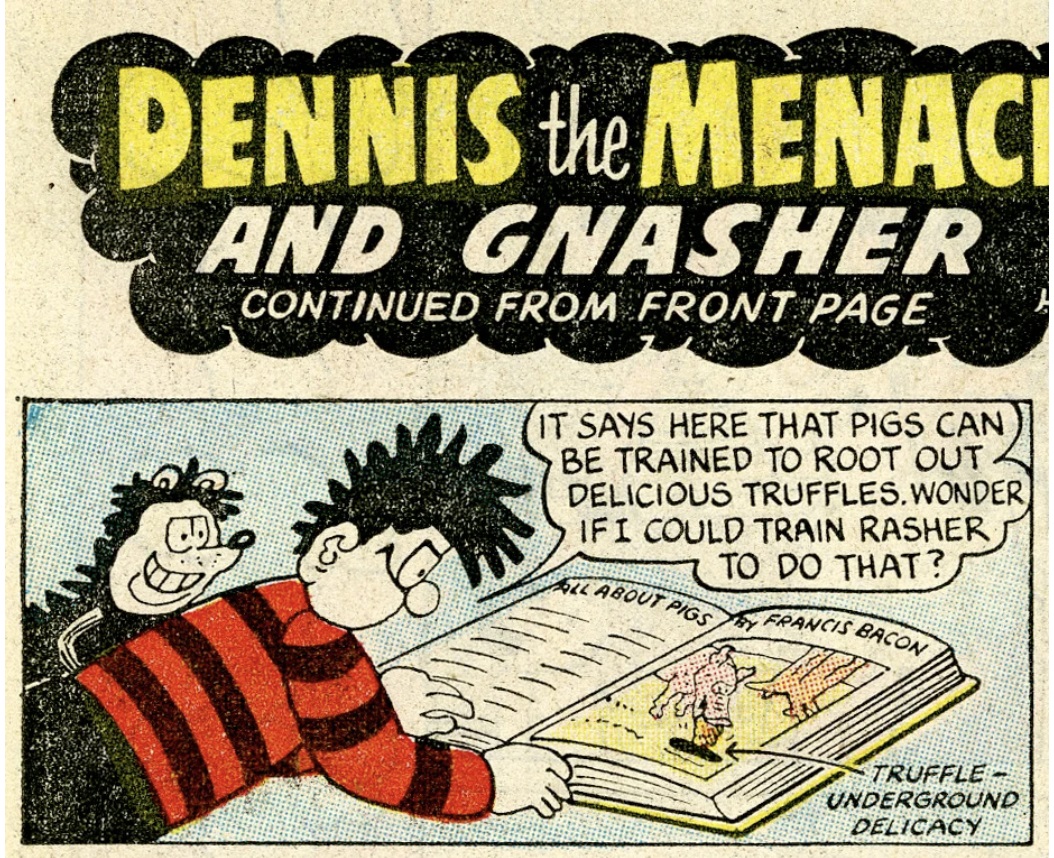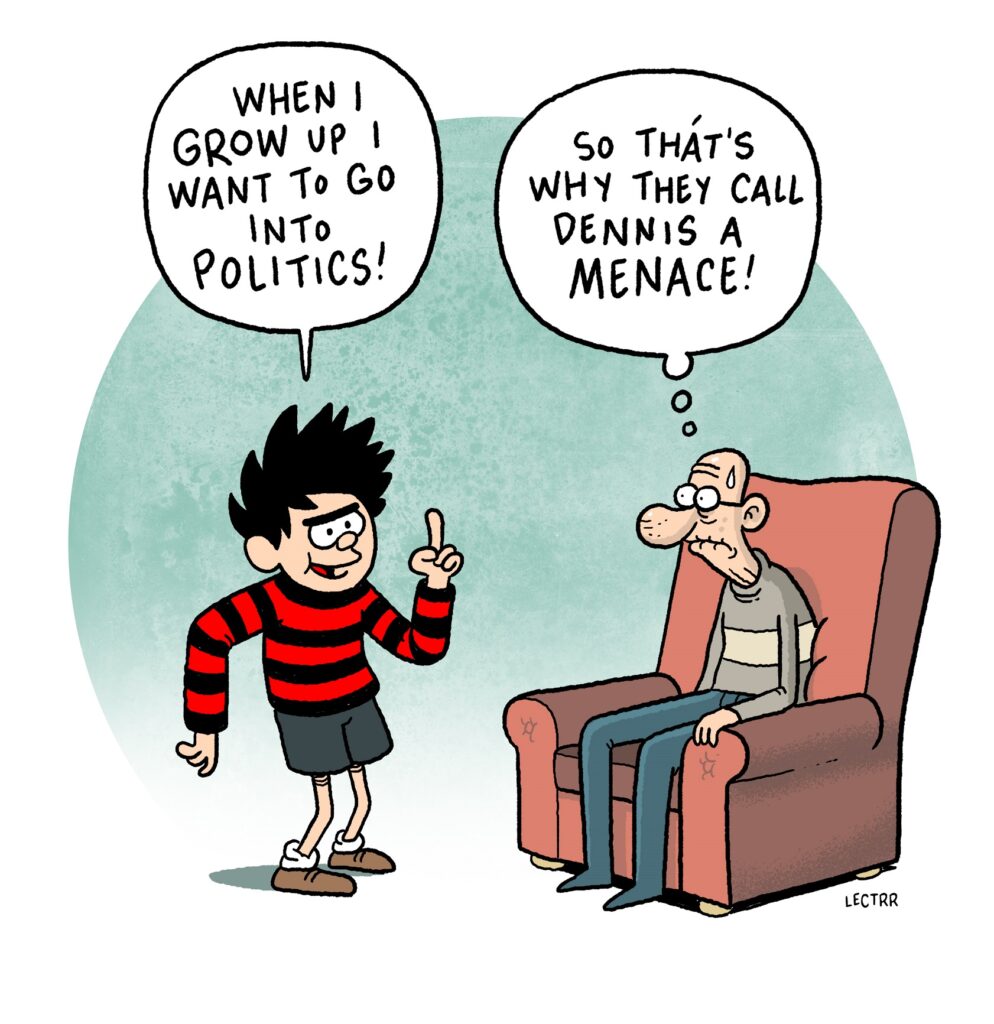It’s no exaggeration to say that the Beano was my bible when I was small - and when I was not so small. How could it be otherwise when I was born just three weeks after Dennis the Menace became the legendary star of the much-loved British comic magazine?
We’ve followed different paths for decades since then, not least because I couldn’t get away with causing the kind of mayhem that Dennis inflicts on his family and society generally. But the bond between us has never been broken. Obviously, I can’t speak for Dennis, because he’s got someone doing that already, but I’m sure he would agree.
When we both recently reached a very significant birthday milestone, British newspapers paid tribute to naughty, chaotic Dennis as the eternal ten-year-old troublemaker.
I got no mention of course, because I’m not one of the best-known and longest-surviving comic book cartoon characters of all time, but my wife often tells people that I’m the eternal five-year-old, so that tells you a lot about us both.
That bond became unbreakable many decades ago when Mr Castro, my form teacher at Oldway Primary School, confiscated the copy of the Beano I was reading under the desk during a boring lesson.
I was mortified in case Mr Castro told my mum and dad, but my classmates hailed me as a rebellious hero, just like Dennis, even though I was really a wimp. Did I put a lit firework in Mr Castro’s desk drawer? Did I soak him with water from the school fire hose? Did I chuck a stink bomb into his briefcase? Did I scare the pants off him and get my comic back? I did none of those things, but in my head, Dennis was a kindred spirit from that moment.
I also felt close to the other Beano stars: Minnie the Minx, Roger the Dodger and Biffo the Bear, all of whom, along with Dennis, gave me a precocious love of alliteration (see what I did there?).
What I also learned from the Beano (and not from Mr Castro) was that words that rhyme don’t necessarily have to be spelt the same. Cold logic suggested to me that my comic hero’s soubriquet should be written as either Dennis the Mennis, or Denace the Menace.
I’d have been even more impressed with the flexibility of rhyme and spelling if I’d known then what I know now: that Dennis’s Beano tag was inspired by the title of a 1935 music hall song called “Dennis the Menace from Venice”.
Dennis goes Dutch
Someone else who was learning stuff from comics was Frits Bolkestein, the Dutch European Commissioner who was responsible for overseeing the EU’s internal market from 1999 to 2004.
Now nearly 90, his English was always better than we Brits can manage, which is far from unusual in this part of the world.
But Bolkestein’s colloquial use of the language was intriguing, and never better than during a UK visit when he found himself being lectured once again by a British Chancellor of the Exchequer about the government’s determination to keep London as the EU’s financial capital.
The Commissioner, knowing full well that you don’t call the Chancellor a mere minister, replied mischievously: “Minister, it’s time to take the needle out of that groove.”
No, he didn’t get that barb from the Beano, but while chatting one day about his use of language, one of his team revealed that he had always loved comics and had taken out a subscription to the Beano for his kids.
I responded enthusiastically and later was invited to lunch with the Commissioner – not, as I expected as a journalist covering EU affairs, to discuss the EU single market, but to talk about comics.
I forget the details, but he had very entertaining things to say about the role of Dennis the Menace, as well as Desperate Dan, the cow-pie-eating cowboy and Korky the Cat, who both appeared in the Beano’s stablemate comic, the Dandy.
He also “came out” as a kids’ comic reader in front of the EU press corps one day, when answering a reporter’s question about Britain’s relationship with its EU partners.
Bolkestein’s reply included his solemn advice to the UK government to “stop carping from the sidelines like Minnie the Minx.”
Blunting the gnashers
In 2018 the Beano became the world’s longest-running weekly comic, but by then Dennis had become, in the words of one British tabloid newspaper, “a politically correct shadow of his former self.” The headline summed him up as “Dennis with no menace."
The same headline could equally apply to an American Dennis the Menace who appeared as a syndicated strip cartoon in 16 US newspapers for the first time on March 12, 1951, five days before the UK Dennis joined the Beano.
It was an unbelievable coincidence: the creators, David Law (UK version) and Hank Ketcham (US version) knew nothing at all of the other’s Dennis until the two debuted in the same week.
But the two characters were very different. From the start, the US Dennis was a wholesome, blond kid who was adventurous but irritatingly well-meaning. His worst offence was watching television beyond his bedtime, any family chaos he caused wasn’t intentional and he was so sweet he was easily forgiven.
The UK Dennis would’ve punched US Dennis on his cutesy button nose, before terrorising his schoolmates with the help of his snarling dog Gnasher and then getting a well-deserved beating from his long-suffering dad.
It was nearly 40 years later that UK Dennis became a reformed character for his cartoon depiction in a children’s television show on the BBC. The poor kid had to lose his catapult, water pistol and peashooter and Gnasher had to stop taking bites out of other characters. Reflecting changing times, a BBC spokesman said: “Dennis can’t be seen to use weapons and giving other kids grief.”
Inevitably Dennis’s image in the Beano was also toned down, which included an end to all “acts of wanton destruction.” Dennis the Menace and Minnie the Minx were both given wide smiles instead of their usual grimaces. Meanwhile, in the Dandy, Desperate Dan’s cow pie habit was reduced so that he wasn’t so fat, and the revolver he usually carried was reduced to a water pistol – presumably the one that Dennis the Menace had to give up.
But nothing has bestowed more respectability and establishment credibility on British comics than a recent whole page in the Financial Times weekend magazine, highlighting the fact that rare copies of the Beano are now collector’s items: a top condition issue of the first one to feature Dennis in 1951 is worth about €1,200 these days. And a copy of the very first Beano in July 1938 was sold at auction for €20,000 in 2015.
The Beano has also been acknowledged in a full-scale exhibition in London honouring the comic’s anarchic spirit. Exhibition curator Andy Holden told the FT: “The Beano is tied into that time when you are going out into the world on your own: it’s a bible of that time.”
Talking of which, there’s even a song called ‘Bible or the Beano’ by a UK band called Ketamine Kim which sounds suitably punky and anarchic.
So, what have we learned from this menacing down the decades? I think we can safely say that Dennis and his chums, despite efforts to tame them, have had the last laugh. Dennis, if you’re reading this, give us a call mate, just for old times’ sake…



